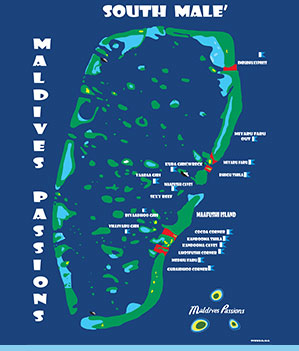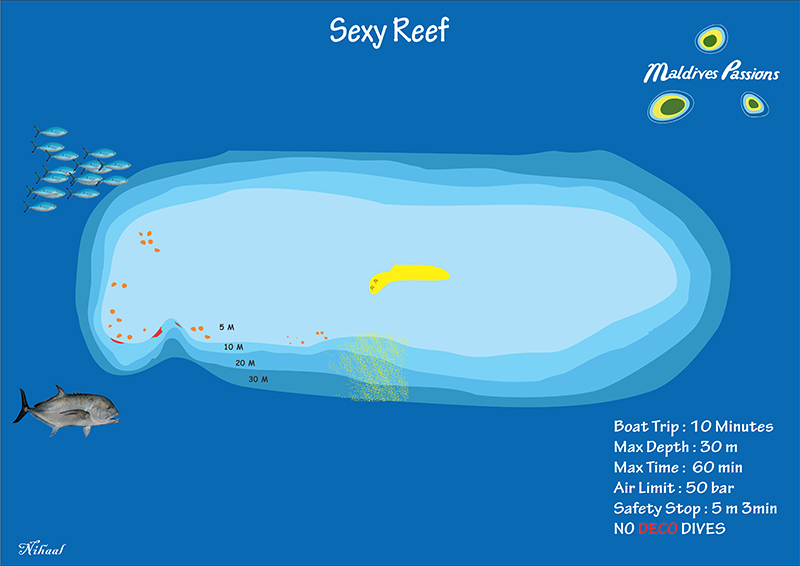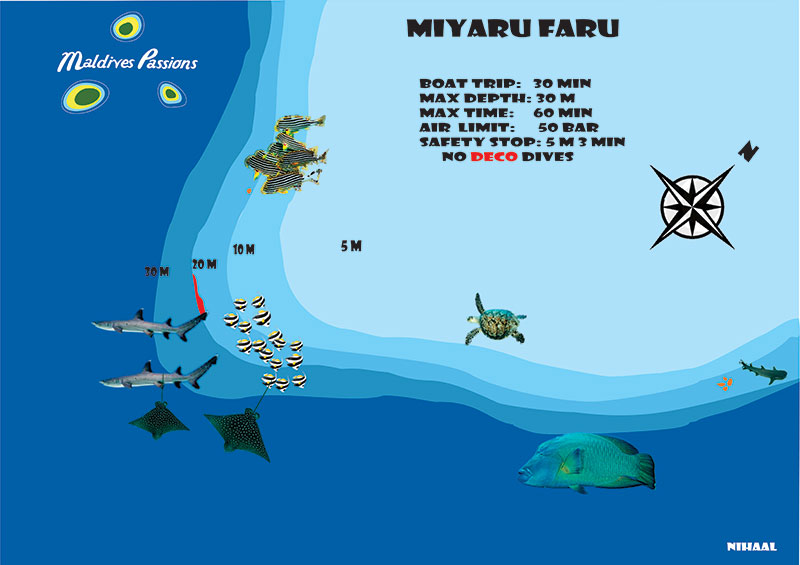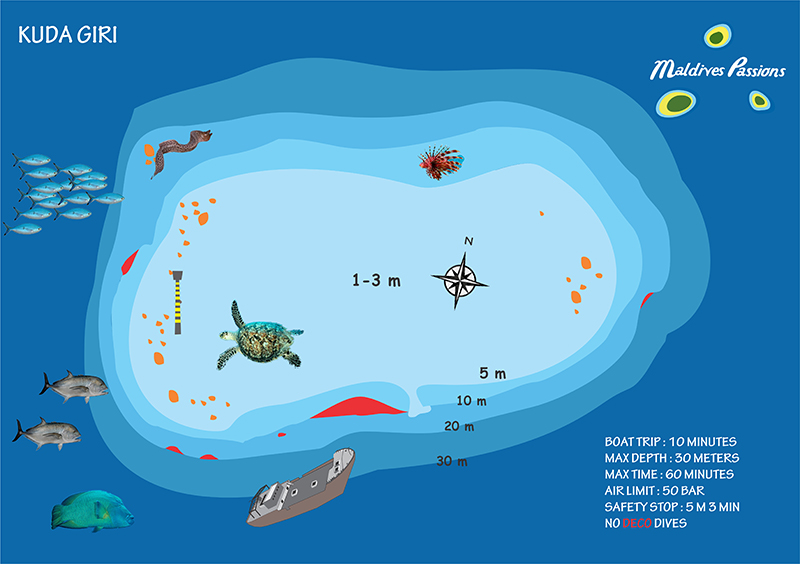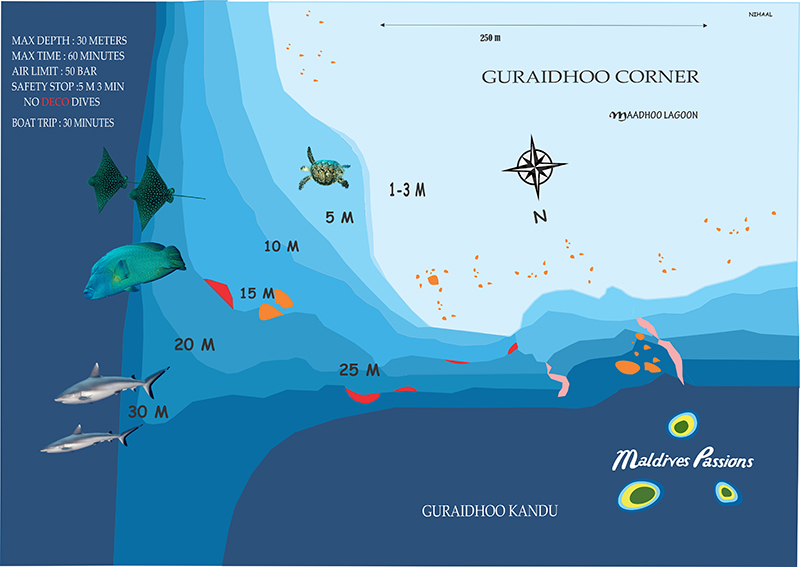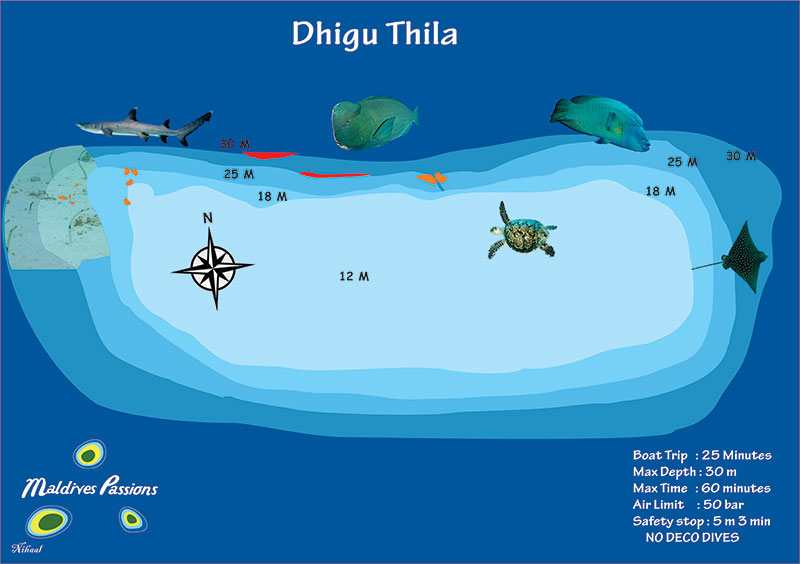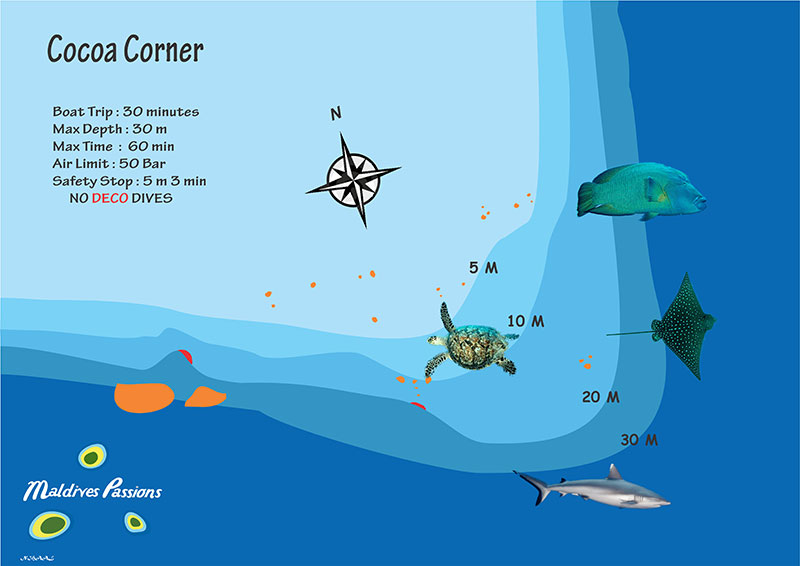Dive sites in the Maldives can be classified into 3 categories:
• Outside reefs• Reef passes
• Thilas
Outside reefs:
From the surface, the reef slopes down gently to 5-10 meters, then drops off (more or less vertically) in a long wall down to 30m... or all the way to the ocean floor !! Made mostly of hard corals, you can find the whole array of tropical fish (surgeonfish, parrotfish, groupers, clown fish, moray eels, etc...) along with turtles.
Passing by in the “blue” (the open ocean) you will be able to observe eagle rays, manta rays, tunas, jackfish, sharks, and if you are lucky even sailfish & dolphins. Current will generally be slow or moderate, perfect for an easy drift dive...
Reef Passes:
This is where the ocean and the lagoon meets … it's the “doorway” to the atoll, so expect a lot of action and some medium to strong current !!
At the entrance of the pass, you will find a “step” around 30 m (sometimes less) where pelagics congregates with the incoming current: plenty of sharks, rays, tunas, jacks, etc...
Once inside the pass, you just drift along the wall all the way to the inside of the atoll... Here you will find hard & soft corals, turtles, and all the “usual” reef fish.
Thilas:
It's the local name for submerged reefs or pinnacles (also called Giri if the top is less than 5m deep).
They can be found inside the atoll, close to (or even inside) reef pass, and depending on the current, you will be able to see some impressive pelagic (sharks, tunas, jack, etc...)
Thilas are generally covered with multicoloured soft corals, a real underwater firework !!
Maafushi is also lucky enough to be close to a nice little wreck, just 15 minutes away
The strength of the current will determine how much fun you have on this site. Moderate current means you will experience one of the Maldives' finest dive sites.
The thila, or pinnacle, is some 300 metres in length and slopes down to around 30 metres. At this spot if you concentrate on the blue you are likely to spot several grey reef sharks & white tip sharks, tuna, jackfish, Napoleon wrass, barracudas, turtles, and even eagle rays.
Grey reef sharks are so prevalent at Kandooma thila, you'll have to keep an eye out for them almost everywhere: at the 30 metres mark, on the top, and at both corners of the thila.
Also at this spot is a series of overhangs where snappers, turtles and sharks all seem to linger.
Sometimes the current here can surprise even the most experienced of dive guides so it is worth planning your dive to include a series of 'rest stops' in sheltered locations. Even if the current is not so strong, these are often the best vantage points anyway.
There are a number of overhangs/caverns here and it is worthwhile to duck into these to avoid the current and to allow you to relax and enjoy the soft corals and the multitude of reef fish.
So providing conditions are conducive, you can drop in here and enjoy one of the most colourful and active site in the South Male area.
Type of dive site: Pinnacle, drift dive
Depth: 15 - 40m
Visibility: 15 - 30m
Current: Can be very strong
Surface conditions: calm, can be choppy
Water temperature: 27 - 30°C
Experience level: Intermediate to advanced
Diving season: All year round
It's is a dive site that can be explored in several different ways and with the right current and conditions, it’s is the best shark show around Male Atoll.
Here divers will see heaps of Grey Reef Sharks from big mothers to newborn babies patrolling the edge of the channel together. Eagle Rays and schooling Jack Fish are also common.
Type of Dive Site: Channel
Best Time to Dive: North East Monsoon when current is incoming
Depth Range: 12m - 30m
Coral Growth: Excellent
Features: Caves, overhangs, coral heads
Fish Life: Abundant
Experience Level: Intermediate to advanced
Often considered among the Maldives' most impressive sites for fish life and photography, Guraidhoo is topographically complex, consisting chiefly of 2 channels and a central reef. It covers such a large area that it can be dived several times in different ways and is subdivided into 3 individual dive sites:
Guraidhoo Corner:
The southern channel is a stretch that runs for about 300 metres and is flanked on each side by vertical walls, which you will drift past effortlessly in the prevailing current.
Where the southern channels meet the abyssal drop, there is often a lot of action such as jacks, tunas and grey reef sharks.
The reef wall provides plenty of current-free indentations where you can take a rest and check out the resident marine creatures, including honeycomb moray eels.
There are an impressive number of soft corals, sea fans and black coral bushes, particularly inside the channel where at 30 metres there is an archway covered with soft corals - a real Kodak moment in the right light.
Losfushi Kandu:
The northern channel is quite different from his southern brother...
The outer reef starts around 5m and drops to 30m+ quite vertically, then the wall eases to a slopping shoal with steps of mixed sand & coral at the entrance of the pass, which lays only 12 to 14m deep.
A narrow sandy area then separates Losfushi kandu from Medhu Faru (the middle reef between the two passes).
This is where the action picks up with eagle rays and patrolling white tip sharks, along with schools of jacks, snappers & oriental sweetlips.
Medhu Faru:
“Middle reef” lays on the southern side of the sandy area in Losfushi kandu pass.
You can often spot white tip shark resting on the bottom here, along with huge Napoleon wrasses and green & hawksbill turtles.
You then drift into the channel, on the opposite side of Guraidhoo corner, where the wall becomes more vertical and studded with overhang covered in hard & soft corals and full of reef fish hunting and hiding from the current.
Type of dive site: Drift dive
Depth: 5 - 40m
Visibility: 25 - 35m
Currents: Can be strong
Water temperature: 27 - 30°C
Experience level: All level
Diving season: All year round
Kuda Giri is a very pretty twenty-years-old wreck that requires a short swim from the reef to reach it.
Well preserved and covered in soft & hard corals, there are lots of glass fish in the holds, and even a few lobsters are hiding in the wreck, with the occasional Napoleon wrasse.
Lion fish, frog fish, leaf fish and stone fish are a common sight here... if you can spot them !!!
The reef itself is pretty nice, with overhangs ans swim-through, nice soft & hard corals and loads of reef fish and big jack fish on the prowl.
Description: Wreck / reef
Depth: 4 - 30m
Visibility: 15-30m
Rating: ****
The thila starts with a flat top around 14m and goes down to a sandy bottom at 25 - 30m.
Nice soft coral can be found inside the caves/overhangs along the wall of the thila.
White tip sharks, eagle rays and turtles are a common sight here.
With an outgoing current, a funnel effect is created, flushing away the organic matter from the inside of the atoll.
This is when mantas take the chance to feed, and the east part of the thila is known as manta point.
If the current is not really strong, there is less chance to see mantas, but the fish life is still very good.
Description: Thila / drift Depth: 3 - 30m Visibility: 15- 30 Rating: ****
It's the house reef of our local uninhabited sand bank, right in front of Maafushi.
We either start directly from the beach or from the boat's anchorage, in 5m of water.
The bottom is a mix of sand and corals, separated from a nice wall studded with overhangs and swim-through, by an underwater dune (sandy slope) where garden eels are concentrated.
You'll find the full array of reef fish there (groupers, lion fish, school of fusiliers, oriental sweet lips & snappers) plus some patrolling tunas and the occasional turtle.
In Dhivehi (the Maldivian language) “Miyaru” means shark, and “Faru” means reef...
“Shark's Reef” it is, then, so I'm sure you'll guess what the main attraction is here!
The outer reef starts around 5m and drops off to 30m+ quite vertically.
The wall then eases closer to the entrance of the pass, which is marked by a step at 29m.
Right at the corner, there is a long overhang around 23m, and this is the place where you'll have to (carefully) grab the reef to enjoy the show: white tip sharks and schools of eagle rays gliding in the incoming current right in front of you...
After “letting go” of the reef, you'll drift into the atoll, along a coral bottom with sandy patches.
Turtles, Napoleon wrasse, trigger fish, schools of snappers & oriental sweet lips can be found here.
Description: Wall / channel / drift dive
Depth: 5 - 30m
Visibility: 15 - 30m
Experience level: All level
It's a marine protected area precisely because of the population of grey reef and white tip sharks that it supports. The dive starts on the south side of the channel and then sinking down to the edge of the pass “step” around 30m. Here is the spot to check out for sharks, rays and Napoleon wrasse that cruise by in the blue just off the reef wall. After a few minutes of taking in the action, you will be led around the corner with the wall on your left shoulder.
There are a series of overhangs and caves sheltering marbled groupers and soldier fish and one particularly large cave is to be explored as it is festooned with colourful sponges.
Your dive here is likely to end by enjoying the drift through a narrow canyon that splits into the channel at about 15m, before continuing to go with the flow into the shallows.
There is another area here which is more or less a dive site in its own right - the north side of the channel. Here there is a thila which rises up to 12m from around 30m. The walls are covered in soft corals and hard corals and provide shelter for an impressive range of marine creatures including moray eels, octopus and lion fish.
Description: Wall / drift dive / Thila
Depth: 5 - 30m
Visibility: 15 - 30m
Surface conditions: Usually calm, can be choppy. Current can be strong.
Experience level: Intermediate to advanced
Number of dive sites: 2
Diving season: All year round

